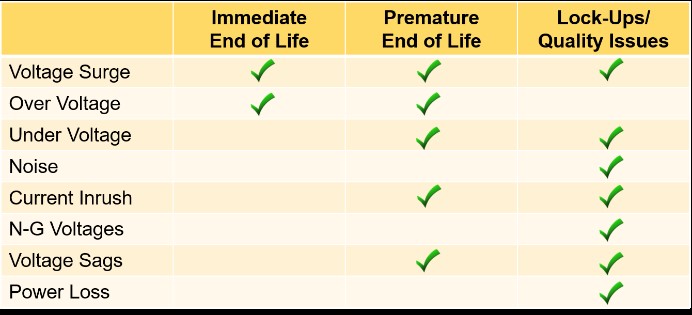Peace of mind for renewable power
As renewable energy advances, power quality becomes more critical, says Lauren Simmen, Ametek Electronic Systems Protection
The demand for renewable energy has risen, both from environmental consciousness and the continual need for power. Renewable energy technology is advancing, and takes many forms, including wind energy, geothermal, solar, hydropower among others.
As each becomes more viable, implementation is accelerating, often based on region and other socio-economic factors. Similarly, power quality can also vary greatly by region. Historically, power anomalies are higher in the United States, compared with Europe and the UK who have newer power grids. The field is being levelled however, as renewable energy sources come online, where complications in integration to the grid can have effects and expenses for homes and businesses.
Disruptive nature
Power anomalies and fluctuations are a common, daily occurrence with a number of causes. The most well-known, and extreme, is lightning strikes, but power anomalies come from other sources such as sustained over-voltages on the grid, voltage sags and swells generated at the grid level or they can be due to wiring issues or neighbouring electrical loads within a building, or brownouts.
Electrical noise is a growing problem, with the increase in wireless devices and the use of switch mode power supplies. Defined as a high-frequency electrical distortion of the voltage waveform, there are two types of noise, electromagnetic interference (EMI) and radio frequency interference (RFI), which can disrupt the clocking frequencies and logic circuits in sophisticated digital equipment, causing lock-ups and equipment malfunctions.
Depending on the magnitude and duration, these power anomalies cause electrical equipment malfunction that can be categorised as immediate equipment failure, premature end of life, or lockups (see Table 1).

Frequency rates
These damaging anomalies will become more frequent due to integration of renewable energy sources. In addition to the power anomalies, additional issues are generated when transitioning between these alternative sources and traditionally generated power, as well as from these new sources themselves. A paper in the International Journal of Current Engineering and Technology, entitled ‘A review on power quality and challenges in renewable energy grid integration’, states: “The stability of the power grid gets affected due to integration of renewable energy, generated in distributed manner,” where “it is very challenging to maintain reliable and healthy power systems”. The paper discusses the negative effects on power quality, such as sags and swells, harmonic distortion, voltage spikes, interruptions, imbalance, noise and more, caused by unpredictable nature of these power generators, variable or non-linear loads, and grid faults. These anomalies have consequences to users, including system breakdown, failure, downtime, or long-term degradation, each of which have direct and indirect costs to homes and businesses.
For example, if a projector in a frequently needs a bulb replacement, the repeated damage could be attributed to power anomalies, instead of a faulty part or product. The downtime can be frustrating for the user who cannot use the system, and costly as a new product has to be repeatedly ordered, or a professional repair has to be arranged. The costs can be even greater for a business. In this environment, a photocopier or a computer system can be disrupted, preventing employees from being able to work properly as an indirect cost. The repair or a new product replacement is a direct cost. Power fluctuations can present in multiple forms of damage, whether in downtime that disrupts business, or degradation over time that impacts the investment on expensive equipment.
Preventing power power
To prevent the negative effects of poor power quality, a power foundation can be constructed from power conditioners and surge protectors to protect against the harmful high frequency voltage and anomalies from getting through to devices, whether from an overloaded system or a grid with a renewable energy source. Noise must be reduced to a safe level of 0.5V or less and devices must also be protected from harmful surge energy. A combination of surge eliminators and power conditioners is needed to safeguard equipment and electronics in homes and businesses both from large surges, plus harmful noise and disruptive fluctuations.
A surge protector is built to handle high levels of surge energy, even including lightning, and should have a long lifespan. Those using metal oxide varistors (MOVs) to handle surge energy have a limited lifespan, and still let harmful energy through to devices. A short expected lifespan of surge protection equipment is telling of inadequate protection. Proper surge protection should have multi-stage technology, like Advanced Series Mode, which neutralises surge energy in addition to an unlimited lifespan, plus filtering for EMI and RFI noise, and zero ground plane contamination.
As renewable energy sources are prioritised and slowly integrated into power grids around the world, the cleanliness and quality of the power that is provided to connected equipment, devices, and systems is at risk. A power foundation takes in the unclean power and provides connected equipment with clean and reliable power with safe frequency and no fluctuations or anomalies. This protects equipment and prevents the direct and indirect costs of poor power quality. Even regions that have historically benefitted from clean power will face these issues as they adopt wind, geothermal, solar and other sustainable sources for power. Users must also be prepared to treat power with the proper technology to prevent the direct and indirect costs associated with power anomalies and noise. A proper power foundation provides comprehensive protection and peace of mind, no matter the cause.










